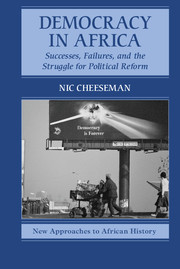Book contents
- Frontmatter
- Dedication
- Epigraph
- Contents
- LIST OF FIGURES
- LIST OF TABLES
- LIST OF ACRONYMS
- ACKNOWLEDGEMENTS
- Introduction: Democratization Against the Odds
- 1 Fragments of Democracy: Participation and Control in Authoritarian Africa
- 2 Cultures of Resistance: Civil Society and the Limits of Power
- 3 The Second Liberation: Economic Decline, the End of the Cold War, and the Struggle for Democracy
- 4 Exporting Elections: International Donors and the Era of Democratic Dependency
- 5 Subverting Democracy: The Advantages of Incumbency and the Politics of Violence
- 6 The Democratic Dividend: Political Competition, Populism, and Public Policy
- Conclusion: Designing Democracy to Manage Diversity and Distrust
- APPENDIX 1 The Fate of Africa's Democratic Experiments 1989–2014
- APPENDIX 1 THE FATE OF AFRICA'S DEMOCRATIC EXPERIMENTS 1989–2014
- INDEX
- References
6 - The Democratic Dividend: Political Competition, Populism, and Public Policy
Published online by Cambridge University Press: 05 May 2015
- Frontmatter
- Dedication
- Epigraph
- Contents
- LIST OF FIGURES
- LIST OF TABLES
- LIST OF ACRONYMS
- ACKNOWLEDGEMENTS
- Introduction: Democratization Against the Odds
- 1 Fragments of Democracy: Participation and Control in Authoritarian Africa
- 2 Cultures of Resistance: Civil Society and the Limits of Power
- 3 The Second Liberation: Economic Decline, the End of the Cold War, and the Struggle for Democracy
- 4 Exporting Elections: International Donors and the Era of Democratic Dependency
- 5 Subverting Democracy: The Advantages of Incumbency and the Politics of Violence
- 6 The Democratic Dividend: Political Competition, Populism, and Public Policy
- Conclusion: Designing Democracy to Manage Diversity and Distrust
- APPENDIX 1 The Fate of Africa's Democratic Experiments 1989–2014
- APPENDIX 1 THE FATE OF AFRICA'S DEMOCRATIC EXPERIMENTS 1989–2014
- INDEX
- References
Summary
On 2 January 2009, all eyes in Ghana turned to the small and unremarkable constituency of Tain. Because of a problem distributing ballot papers, the people of Tain had not voted in the second round of the presidential election at the same time as the country's 229 other constituencies. When they went to the polls four days later, it was in the knowledge that their actions would determine the next government of Ghana.
The presidential contest had been close from the start. The candidate of the ruling New Patriotic Party (NPP), Nana Akufo-Addo, had won the first round with 4, 159, 439 votes. But the main opposition leader, John Atta Mills of the National Democratic Congress (NDC), had also done well, receiving 4, 056, 634 votes – just 102, 805 behind. As no candidate achieved an absolute majority, Akufo-Addo and Mills contested a run-off. The second ballot turned out to be even closer than the first. Because many of the candidates who dropped out of the race threw their support behind the NDC, Mills was able to fashion a narrow lead of just 23, 000 votes. But Tain had not voted, and the number of registered voters in the constituency (53, 000) was greater than the margin between the two candidates.
Aware that the NDC had significant support in Tain, and that it was therefore unfeasible to overturn Mills's lead, the NPP government sought an injunction to delay the poll, claiming that the atmosphere was not conducive to a free and fair election. When this strategy failed the NPP, panicked by the prospect of losing power, called on its supporters to boycott the vote, a move that was heavily criticized by opposition parties and civil society groups. As tensions rose, fears of electoral violence increased and the government deployed police and soldiers to keep the peace. During this period a group of filmmakers gained rare access to the “strong room” of the electoral commission where results are transmitted, counted, and verified.
- Type
- Chapter
- Information
- Democracy in AfricaSuccesses, Failures, and the Struggle for Political Reform, pp. 171 - 202Publisher: Cambridge University PressPrint publication year: 2015

